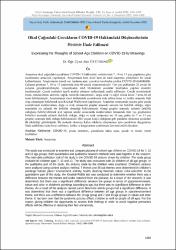Okul çağındaki çocukların Covıd-19 hakkındaki düşüncelerinin resimle ifade edilmesi
Citation
Üstündağ, A. (2022). Okul Çağındaki Çocukların COVID-19 Hakkındaki Düşüncelerinin Resimle İfade Edilmesi . Afyon Kocatepe Üniversitesi Sosyal Bilimler Dergisi , 24 (4) , 1484-1499 . DOI: 10.32709/akusosbil.811940Abstract
Araştırma okul çağındaki çocukların COVID-19 hakkındaki resimlerinin 7, 10 ve 13 yaş gruplarına göre incelenmesi amacıyla yapılmıştır. Araştırmada hem nicel hem de nitel araştırma yöntemleri bir arada kullanılmıştır. Araştırmanın temel veri toplama aracı çocuklar tarafından çizilen COVID-19 resimleridir. Çalışma grubunu 7, 10 ve 13 yaşlarında olan 60 çocuk oluşturmaktadır. Her yaş grubundan 20 çocuk ile çalışma gerçekleştirilmiştir. Araştırmanın nitel bölümünde çocuklar tarafından yapılan resimler incelenmiştir. Çocuk resimleri içerik analizi yöntemi kullanılarak analiz edilmiştir. Çocuk resimlerinde insan, mekân/ortam, aktivite, sağlık, temizlik malzemeleri, doğa, renk ve diğer olmak üzere 7 tema 48 alt tema belirlenmiştir. Araştırmanın nicel bölümünde resimlerden elde edilen tema ve kodlar arasında fark olup olmadığını belirlemek için Kruskal-Wallis testi yapılmıştır. Araştırma sonucunda yaşlara göre çocuk resimlerinde mekân/ortam, doğa ve renk temasında gruplar arasında anlamlı bir farklılık olduğu, diğer temalarda ise anlamlı bir farklılık olmadığı belirlenmiştir. Hangi gruplar arasında anlamlı farklılık olduğunu belirleyebilmek için yapılan analiz sonucunda mekân/ortam temasında tüm yaş gruplarının birbirleri arasında anlamlı farklılık olduğu, doğa ve renk temasında ise 10 yaş grubu ile 7 ve 13 yaş grupları arasında fark olduğu belirlenmiştir. Her yaştan kişiyi olduğunu gibi pandemi sürecinin çocukları da etkilediği görülmüştür. Bu nedenle olumsuz kalıcı etkilerin oluşmaması için çocukların duygularını ifade edebilmesi için fırsat verilmesi, korku ve kaygılarının azaltılması üzerinde etkili olacaktır. The study was conducted to examine and compare pictures of school-age children on COVID-19 for 7, 10 and 13 age groups. Both quantitative and qualitative research methods were used together in the research. The main data collection tool of the study is the COVID-19 pictures drawn by children. The study group included 60 children aged 7, 10 and 13. The study was conducted with 20 children of all age groups. In the qualitative part of the study, the pictures made by the children were examined. Children's pictures were analyzed using content analysis method. 7 themes and 48 sub-themes were determined in children's paintings: human, place / environment, activity, health, cleaning materials, nature, color and other. In the quantitative part of the study, the Kruskal-Wallis test was conducted to determine whether there was a difference between the themes and codes obtained from the pictures. As a result of the research, it was determined that there was a significant difference between the groups in terms of space/environment, nature and color in children's paintings according to age, but there was no significant difference in other themes. As a result of the analysis carried out to determine which groups had a significant difference, it was determined that there was a significant difference between all age groups in space/environment theme, and there was a difference between the 10 age group and 7 and 13 age groups in nature and color theme. It has been seen that the pandemic process affects children as well as people of all ages. For this reason, giving children the opportunity to express their feelings in order to avoid negative permanent effects will be effective in reducing their fear and anxiety.
Source
Afyon Kocatepe Üniversitesi Sosyal Bilimler DergisiVolume
24Issue
4Collections
- Cilt 24 : Sayı 4 [25]



















